The morning after our 3,000’ climb to Throng La and 5,000’ descent to Muktinath, we wake and do a part check. Mark: sore quads, sore right foot (a lingering metatarsal injury). Me: sore quads, stuffy nose, and working left knee. With a dose of ibuprofen, we both feel better. It’s the first day of the trip where we feel any soreness in our legs. All that downhill did us in!
To Buddhists and Hindus, Muktinath is the most important pilgrimage site in Nepal’s Himalayas. There is a large shrine complex where both Buddhists and Hindus visit, and within the complex is a place where a natural flame of ignited methane burns up and through a natural spring. This combination of earth, fire and water is considered auspicious and is the reason for Muktinath’s establishment as a holy site.
We visit the temple complex with Pemba, and find the Hindu Shiva Temple to be the most populated spot. It has 108 brass waterspouts in the shape of cows’ heads; at nearly 13,000 feet of elevation, the water pouring from the spouts was quite recently snow. Hindu men strip down to their underwear and run the gauntlet underneath the spouts, trying not to slip on the wet stones. It looks invigorating and excruciatingly cold!
Leading to the temple is a busy road that runs all the way from the lowlands to Muktinath. For the first time in over a week, we see jeeps, 4X4’s and huge trucks, creating an atmosphere completely different from that in the villages – Manang, Bragha, Pisang, Chame – from which we just came. Horns blasting us to get out of the way unsettle our nerves, and we decide to leave the jeep road as quickly as we can.
We decide to take a detour through the little-visited village of Jhong, a somewhat longer route that will keep us off the main road for another day. Many trekkers end their trip in Muktinath and take a jeep ride to Jomsom, or even back to Pokhara. That’s not our plan – we want to walk the entire Circuit. Pemba has never been to Jhong either, so it’s a new experience for all of us. Having hiked the Annapurna Circuit about 20 times, he’s up for something new. Tsering has no interest in carrying our packs an extra few miles; he hops on a bus to our next stop, Kagbeni, to get us a room.
Leaving Muktinath, we pass through fields of buckwheat, wheat and corn. The autumn colors are stunning, the valley filled with gold-leafed birch trees. An hour later we arrive in Jhong, and Pemba asks around and finds a guesthouse willing to cook us lunch. Unlike places we ate along the official trail, there is no menu at this off-the-beaten-path guesthouse. There is no need for a menu as they serve the one thing every Nepali eats: dal bhat. And it turns out to be the best dal bhat we will eat during our entire stay in Nepal! In addition to the standard white rice and lentil-based dal, they also serve sautéed greens straight from their garden, curried potatoes, and spicy pickles. We sit on the roof of the guesthouse overlooking the golden valley and the village and think: this is good. Remember this.
After lunch we walk to Jhong’s gompa, the 16th century Chode Shedrup Choephel Ling Monastery. The gompa is an active place, with several young boys running around. We learn nine boys live there with the monks, learning Buddhist philosophy in addition to math, reading, history, and more. The boys seem very happy and well-cared for. Inside the gompa are brightly painted murals depicting the life of Buddha and various deities. One of the most striking is a “Wheel of Life” mural, showing the 12 stages of life and the six worlds of Buddhism (this interactive website does a good job explaining what the different parts of the image mean). At the gompa, we encounter one other foreigner, in fact the first and only foreigner we will see until we reach Kagbeni.
Inside the monastery, we find a few murals covered with cloth; the caretaker explains that the gods depicted in these particular murals are being prayed to at that moment in a sacred room upstairs. After briefly chatting and getting a picture with the resident monks, we realize that it is nearly 3PM and we still have hours of walking ahead of us. We bid our farewell, and get back on the trail.
There’s a peace and a rhythm to walking for hours at a time, and we fall into a quick pace as we head out along the arid back road to Kagbeni. No other trekkers walk here. Occasionally a jeep passes us, but it is a rare event. The wind picks up, and Pemba tells us the next few days will have very windy afternoons, weather typical for the north side of the Annapurnas. The wind gusts strongly, mostly pushing us along the trail, but occasionally swirling into a dust devil and carrying high into the cerulean sky the red desert earth, along with anything of ours that is not firmly attached. It is invigorating and exciting to be in such active weather with no one else around. We pass salt fields and dry creek beds, but no animals and very little plant life; this is the Mustang desert created by the rain shadow of the Annapurnas.
Hours later we arrive in Kagbeni, a town with cobbled streets and closely packed mud and stone houses. We contemplate going to YacDonalds for dinner – its red and yellow signage is quite familiar – but we pass and opt for an early dinner at our hotel instead.
Tomorrow we are back to the busy road, the dust, and the wind.
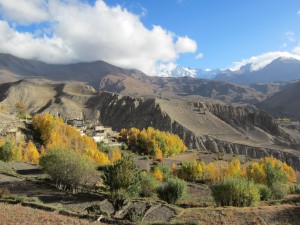
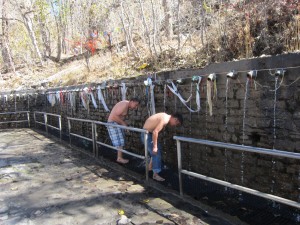
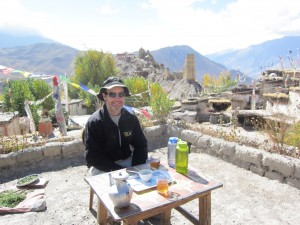
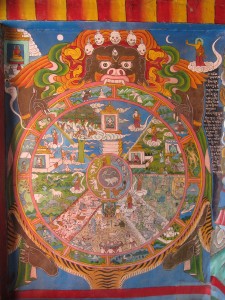
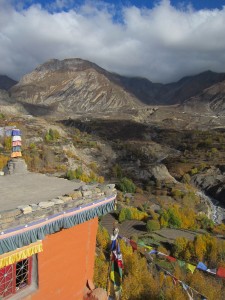
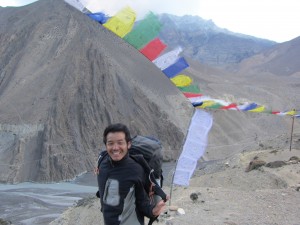
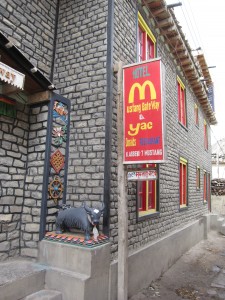
{ 5 comments… read them below or add one }
A fascinating trip, made so by your great commentary and photos! Glad to see you are holding up physically and able to to enjoy every moment.
I can’t wait for the next installment.
I remember the road to Muktinath well, though I walked it in the opposite direction, and never actually crossed over Thorung La. It sounds like it was as memorable for you as it was for me…I look forward to comparing notes when next we see each other!
Hope both of you are well and happy.
Thanks Steve! We are back in the States now, and I have high hopes better internet connections will translate into more posts and photos 🙂 Hope you and Connie are well!
We need to compare pictures too – we’re very curious to see how it changed since you were (and there was no road to Muktinath!).
great blog, thank you, the smaller villages are very interesting, planning to do this trek next march,2014. do you have a map or links of how to get from jharkot to jhong ? thank you again.